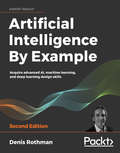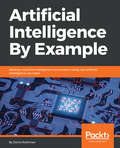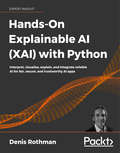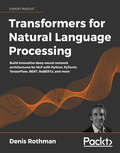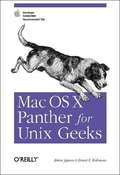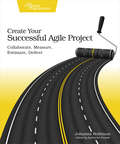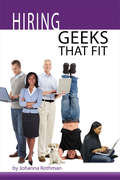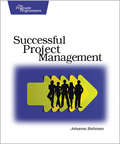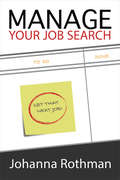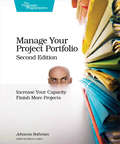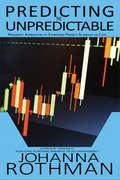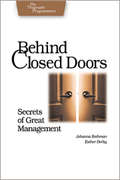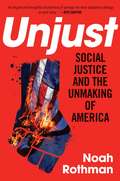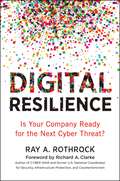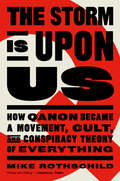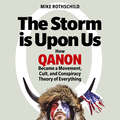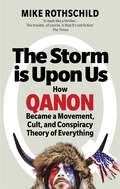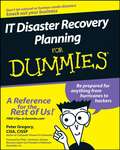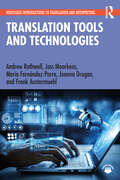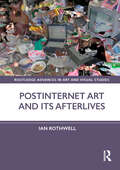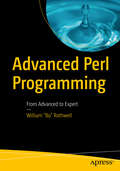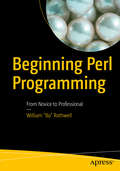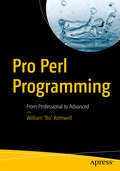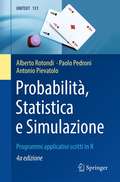- Table View
- List View
CFN Lectures on Functional Nanostructures - Volume 2: Nanoelectronics (Lecture Notes in Physics #820)
by Christian Röthig Matthias Vojta Gerd SchönThis series of books contains selected and edited lectures from summer schools organized by the Center for Functional nanostructures (CFN) at the University of Karlsruhe. The mission of the CFN is to carry out research in the following areas: nanophotonics, nanoelectronics, molecular nanostructures and nanostructured materials. The aim of the summer schools is mainly to exchange new ideas and illustrate emerging research methodologies through a series of topical, introductory lectures. This is reflected by both the selection of topics addressed in the present volume, nanoelectronics, as well as the tutorial aspect of the contributions.
Artificial Intelligence By Example: Acquire advanced AI, machine learning, and deep learning design skills, 2nd Edition
by Denis RothmanUnderstand the fundamentals and develop your own AI solutions in this updated edition packed with many new examples Key Features AI-based examples to guide you in designing and implementing machine intelligence Build machine intelligence from scratch using artificial intelligence examples Develop machine intelligence from scratch using real artificial intelligence Book Description AI has the potential to replicate humans in every field. Artificial Intelligence By Example, Second Edition serves as a starting point for you to understand how AI is built, with the help of intriguing and exciting examples. This book will make you an adaptive thinker and help you apply concepts to real-world scenarios. Using some of the most interesting AI examples, right from computer programs such as a simple chess engine to cognitive chatbots, you will learn how to tackle the machine you are competing with. You will study some of the most advanced machine learning models, understand how to apply AI to blockchain and Internet of Things (IoT), and develop emotional quotient in chatbots using neural networks such as recurrent neural networks (RNNs) and convolutional neural networks (CNNs). This edition also has new examples for hybrid neural networks, combining reinforcement learning (RL) and deep learning (DL), chained algorithms, combining unsupervised learning with decision trees, random forests, combining DL and genetic algorithms, conversational user interfaces (CUI) for chatbots, neuromorphic computing, and quantum computing. By the end of this book, you will understand the fundamentals of AI and have worked through a number of examples that will help you develop your AI solutions. What you will learn Apply k-nearest neighbors (KNN) to language translations and explore the opportunities in Google Translate Understand chained algorithms combining unsupervised learning withdecision trees Solve the XOR problem with feedforward neural networks (FNN) and buildits architecture to represent a data flow graph Learn about meta learning models withhybrid neural networks Create a chatbot and optimize its emotional intelligence deficiencies withtools such as Small Talk and data logging Building conversational user interfaces (CUI) for chatbots Writing genetic algorithms that optimizedeep learning neural networks Build quantum computing circuits Who this book is for Developers and those interested in AI, who want to understand the fundamentals of Artificial Intelligence and implement them practically. Prior experience with Python programming and statistical knowledge is essential to make the most out of this book.
Artificial Intelligence By Example: Develop machine intelligence from scratch using real artificial intelligence use cases
by Denis RothmanBe an adaptive thinker that leads the way to Artificial IntelligenceKey FeaturesAI-based examples to guide you in designing and implementing machine intelligenceDevelop your own method for future AI solutionsAcquire advanced AI, machine learning, and deep learning design skillsBook DescriptionArtificial Intelligence has the potential to replicate humans in every field. This book serves as a starting point for you to understand how AI is built, with the help of intriguing examples and case studies.Artificial Intelligence By Example will make you an adaptive thinker and help you apply concepts to real-life scenarios. Using some of the most interesting AI examples, right from a simple chess engine to a cognitive chatbot, you will learn how to tackle the machine you are competing with. You will study some of the most advanced machine learning models, understand how to apply AI to blockchain and IoT, and develop emotional quotient in chatbots using neural networks.You will move on to designing AI solutions in a simple manner rather than get confused by complex architectures and techniques. This comprehensive guide will be a starter kit for you to develop AI applications on your own.By the end of this book, will have understood the fundamentals of AI and worked through a number of case studies that will help you develop business vision.What you will learnUse adaptive thinking to solve real-life AI case studiesRise beyond being a modern-day factory code workerAcquire advanced AI, machine learning, and deep learning designing skillsLearn about cognitive NLP chatbots, quantum computing, and IoT and blockchain technologyUnderstand future AI solutions and adapt quickly to themDevelop out-of-the-box thinking to face any challenge the market presentsWho this book is forArtificial Intelligence by Example is a simple, explanatory, and descriptive guide for junior developers, experienced developers, technology consultants, and those interested in AI who want to understand the fundamentals of Artificial Intelligence and implement it practically by devising smart solutions. Prior experience with Python and statistical knowledge is essential to make the most out of this book.
Hands-On Explainable AI (XAI) with Python: Interpret, visualize, explain, and integrate reliable AI for fair, secure, and trustworthy AI apps
by Denis RothmanThis book is not an introduction to Python programming or machine learning concepts. You must have some foundational knowledge and/or experience with machine learning libraries such as scikit-learn to make the most out of this book. Some of the potential readers of this book include: • Professionals who already use Python for as data science, machine learning, research, and analysis • Data analysts and data scientists who want an introduction into explainable AI tools and techniques • AI Project managers who must face the contractual and legal obligations of AI Explainability for the acceptance phase of their applications
Transformers for Natural Language Processing: Build innovative deep neural network architectures for NLP with Python, PyTorch, TensorFlow, BERT, RoBERTa, and more
by Denis RothmanBecome an AI language understanding expert by mastering the quantum leap of Transformer neural network modelsKey FeaturesBuild and implement state-of-the-art language models, such as the original Transformer, BERT, T5, and GPT-2, using concepts that outperform classical deep learning modelsGo through hands-on applications in Python using Google Colaboratory Notebooks with nothing to install on a local machineLearn training tips and alternative language understanding methods to illustrate important key conceptsBook DescriptionThe transformer architecture has proved to be revolutionary in outperforming the classical RNN and CNN models in use today. With an apply-as-you-learn approach, Transformers for Natural Language Processing investigates in vast detail the deep learning for machine translations, speech-to-text, text-to-speech, language modeling, question answering, and many more NLP domains with transformers. The book takes you through NLP with Python and examines various eminent models and datasets within the transformer architecture created by pioneers such as Google, Facebook, Microsoft, OpenAI, and Hugging Face. The book trains you in three stages. The first stage introduces you to transformer architectures, starting with the original transformer, before moving on to RoBERTa, BERT, and DistilBERT models. You will discover training methods for smaller transformers that can outperform GPT-3 in some cases. In the second stage, you will apply transformers for Natural Language Understanding (NLU) and Natural Language Generation (NLG). Finally, the third stage will help you grasp advanced language understanding techniques such as optimizing social network datasets and fake news identification. By the end of this NLP book, you will understand transformers from a cognitive science perspective and be proficient in applying pretrained transformer models by tech giants to various datasets.What you will learnUse the latest pretrained transformer modelsGrasp the workings of the original Transformer, GPT-2, BERT, T5, and other transformer modelsCreate language understanding Python programs using concepts that outperform classical deep learning modelsUse a variety of NLP platforms, including Hugging Face, Trax, and AllenNLPApply Python, TensorFlow, and Keras programs to sentiment analysis, text summarization, speech recognition, machine translations, and moreMeasure the productivity of key transformers to define their scope, potential, and limits in productionWho this book is forSince the book does not teach basic programming, you must be familiar with neural networks, Python, PyTorch, and TensorFlow in order to learn their implementation with Transformers. Readers who can benefit the most from this book include deep learning & NLP practitioners, data analysts and data scientists who want an introduction to AI language understanding to process the increasing amounts of language-driven functions.
Mac OS X Panther for Unix Geeks
by Ernest E. Rothman Brian JepsonWith its rep for being the sort of machine that won't intimidate even the most inexperienced users, what's the appeal of the Mac for hard-core geeks? The Mac has always been an efficient tool, pleasant to use and customize, and eminently hackable. But now with Mac OS X's BSD core, many a Unix developer has found it irresistible. The latest version of Mac OS X, called Panther, makes it even easier for users to delve into the underlying Unix operating system. In fact, you can port Linux and Unix applications and run them side-by-side with your native Aqua apps right on the Mac desktop. Still, even experienced Unix users may find themselves in surprisingly unfamiliar territory as they set out to explore Mac OS X. Even if you know Macs through and through, Mac OS X Panther is unlike earlier Macs, and it's radically different from the Unix you've used before. Enter Mac OS X Panther for Unix Geeks by Brian Jepson and Ernest E. Rothman, two Unix geeks who found themselves in the same place you are. The new edition of this book is your guide to figuring out the BSD Unix system and Panther-specific components that you may find challenging. This concise book will ease you into the Unix innards of Mac OS X Panther, covering such topics as: A quick overview of the Terminal application, including Terminal alternatives like iTerm and GLterm Understanding Open Directory (LDAP) and NetInfo Issues related to using the GNU C Compiler (GCC) Library linking and porting Unix software An overview of Mac OS X Panther's filesystem and startup processes Creating and installing packages using Fink and Darwin Ports Building the Darwin kernel Using the Apple X11 distribution for running X Windows applications on top of Mac OS X The book wraps up with a quick manpage-style reference to the "Missing Manual Pages" --commands that come with Mac OS X Panther, although there are no manpages. If you find yourself disoriented by the new Mac environment, Mac OS X Panther for Unix Geeks will get you acclimated quickly to the foreign new areas of a familiar Unix landscape.
Create Your Successful Agile Project: Collaborate, Measure, Estimate, Deliver
by Johanna RothmanYou think agile techniques might be for you, but your projects and organization are unique. An "out-of-the-box" agile approach won't work. Instead, unite agile and lean principles for your project. See how to design a custom approach, reap the benefits of collaboration, and deliver value. For project managers who want to use agile techniques, managers who want to start, and technical leaders who want to know more and succeed, this book is your first step toward agile project success. You've tried to use an off-the-shelf approach to agile techniques, and it's not working. Instead of a standard method or framework, work from agile and lean principles to design your own agile approach in a way that works for you. Build collaborative, cross-functional teams. See how small batch sizes and frequent delivery create an environment of trust and transparency between the team, management, and customers. Learn about the interpersonal skills that help agile teams work together so well. In addition to seeing work and knowing what "done" means, you'll see examples of many possible team-based measurements. Look at tools you can use for status reporting, and how to use those measurements to help your managers understand what agile techniques buy them. Recognize the traps that prevent agile principles from working in too many organizations, and what to do about those traps. Use agile techniques for workgroups, and see what managers can do to create and nurture an agile culture. You might be surprised at how few meetings and rituals you need to still work in an agile way. Johanna's signature frankness and humor will get you on the right track to design your agile project to succeed. What You Need:No technical expertise or experience needed, just a desire to know more about how you might use agile in your project.
Hiring Geeks That Fit
by Johanna Rothman"Do you want to hire great people? Not sure how? Read this book.Knowledge workers -- your geeks -- are different from skill-based staff. So, you should hire them differently. You need to analyze your situation, determine the problems you have, understand your culture, and then you can hire the right kinds of people.Cultural fit is critical, because we rarely fire people based on technical skill. But we frequently fire them because of that elusive fit. And, that's an expensive proposition.Hiring great geeks forces you to recognize and match culture, non-technical qualities, preferences and skills, and finally, technical skills. These people will adapt their knowledge to your specific situation, the context. They are the sum of both what they know and how they apply that knowledge to the product.As a result, one developer, tester, or technical manager is not interchangeable with another. This makes hiring technical people one of the most critical and difficult processes a technical manager or team can undertake.Hiring Geeks That Fit takes the guesswork out of hiring and reduces the risk of costly hiring mistakes. You'll learn how to:Develop a hiring strategy so you know how to solve your problemAnalyze the job, so the job description and ad falls out of the analysisI Source candidates, using a variety of approaches including LinkedIn and TwitterDevelop effective ads for different mediumsReview resumes quickly to determine Yes, No, or Maybe candidatesDevelop behavior-description questions and auditionsCreate phone screens that help you know who to bring in for an in-person interviewMake the most of an in-person interviewCheck referencesExtend an offer that will attract a win-win acceptance or tender a gentle-but-decisive rejectionCreate a great first day experience for new hiresLearn how to create a buddy system to decrease the cost of a new hireWhat to do if you can't find someoneYou, your team, and your organization will live with the long-term consequences of your hiring decision. Investing the time for you and your team in how to hire and interview will pay off fast.This book was written and produced entirely by the author. We are proud to be distributing it."
Manage It!: Your Guide to Modern, Pragmatic Project Management
by Johanna RothmanThis book is a reality-based guide for modern projects. You'll learn how to recognize your project's potholes and ruts, and determine the best way to fix problems - without causing more problems.Your project can't fail. That's a lot of pressure on you, and yet you don't want to buy into any one specific process, methodology, or lifecycle.Your project is different. It doesn't fit into those neat descriptions.Manage It! will show you how to beg, borrow, and steal from the best methodologies to fit your particular project. It will help you find what works best for you and not for some mythological project that doesn't even exist.Before you know it, your project will be on track and headed to a successful conclusion.
Manage Your Job Search
by Johanna Rothman"A job search is an emergent project. How do you handle an emergent project? By creating a system that allows for serendipity and flexibility: personal kanban and one-week timeboxes.Once you have a system, you can use the tips in Part 2 to prepare for your job search: choose your career, write your resume, prepare for your interviews, and decide how you will decide on an offer. In Part 3, you'll learn how to network without feeling slimy. You'll learn to build your target network, where to look for the jobs that you need, and how to spot the warning signs of a job that organizations might no longer need. There are many traps for unsuspecting job hunters, so Part 4 has a section on traps to avoid and tips to try. If you're in special circumstances, such as being a new grad, in a career transition, or over 50, then Part 5 is for you. Even if you've been diligent, any job search can take more than three months. Part 6 addresses your feelings and how to persevere when your search seems as if it takes forever.Written with her trademark practicality, humor, and empathy, Johanna will help you learn how to find your next job.This book was written and produced entirely by the author. We are proud to be distributing it."
Manage Your Project Portfolio: Increase Your Capacity and Finish More Projects
by Johanna RothmanYou have too many projects, and firefighting and multitasking are keeping you from finishing any of them. You need to manage your project portfolio. This fully updated and expanded bestseller arms you with agile and lean ways to collect all your work and decide which projects you should do first, second, and never. See how to tie your work to your organization's mission and show your managers, your board, and your staff what you can accomplish and when. Picture the work you have, and make those difficult decisions, ensuring that all your strength is focused where it needs to be. All your projects and programs make up your portfolio. But how much time do you actually spend on your projects, and how much time do you spend on emergency fire drills or waste through multitasking? This book gives you insightful ways to rank all the projects you're working on and figure out the right staffing and schedule so projects get finished faster.The trick is adopting lean and agile approaches to projects, whether they're software projects, projects that include hardware, or projects that depend on chunks of functionality from other suppliers. Find out how to define the mission of your team, group, or department, with none of the buzzwords that normally accompany a mission statement. Armed with the work and the mission, you'll manage your portfolio better and make those decisions that define the true leaders in the organization. With this expanded second edition, discover how to scale project portfolio management from one team to the entire enterprise, and integrate Cost of Delay when ranking projects. Additional Kanban views provide even more ways to visualize your portfolio.
Predicting the Unpredictable
by Johanna Rothman"If you have trouble estimating cost or schedule for your projects, you are not alone. The question is this: who wants the estimate and why?The definition of estimate is to guess. But too often, the people who want estimates want commitments. Instead of a commitment, you can apply practical and pragmatic approaches to developing estimates and then meet your commitments. You can provide your managers with the information they want and that you can live with.Learn how to use different words for your estimates and how to report an estimate that includes uncertainty. Learn who should and should not estimate. Learn how to update your estimate when you know more about your project.Regain estimation sanity. Learn practical and pragmatic ways to estimate schedule or cost for your projects."
Behind Closed Doors: Secrets of Great Management (Pragmatic Programmers)
by Johanna Rothman Esther DerbyGreat management is difficult to see as it occurs. It's possible to see the results of great management, but it's not easy to see how managers achieve those results. Great management happens in one-on-one meetings and with other managers---all in private. It's hard to learn management by example when you can't see it.You can learn to be a better manager---even a great manager---with this guide. You'll follow along as Sam, a manager just brought on board, learns the ropes and deals with his new team over the course of his first eight weeks on the job. From scheduling and managing resources to helping team members grow and prosper, you'll be there as Sam makes it happen. You'll find powerful tips covering:Delegating effectivelyUsing feedback and goal-settingDeveloping influenceHandling one-on-one meetingsCoaching and mentoringDeciding what work to do---and what not to do...and more.Full of tips and practical advice on the most important aspects of management, this is one of those books that can make a lasting andimmediate impact on your career.
Unjust: Social Justice and the Unmaking of America
by Noah Rothman"An elegant and thoughtful dismantling of perhaps the most dangerous ideology at work today." — BEN SHAPIRO, bestselling author and host of "The Ben Shapiro Show" "Reading Noah Rothman is like a workout for your brain." — DANA PERINO, bestselling author and former press secretary to President George W. Bush There are just two problems with “social justice”: it’s not social and it’s not just. Rather, it is a toxic ideology that encourages division, anger, and vengeance. In this penetrating work, Commentary editor and MSNBC contributor Noah Rothman uncovers the real motives behind the social justice movement and explains why, despite its occasionally ludicrous public face, it is a threat to be taken seriously. American political parties were once defined by their ideals. That idealism, however, is now imperiled by an obsession with the demographic categories of race, sex, ethnicity, and sexual orientation, which supposedly constitute a person’s “identity.” As interest groups defined by identity alone command the comprehensive allegiance of their members, ordinary politics gives way to “Identitarian” warfare, each group looking for payback and convinced that if it is to rise, another group must fall. In a society governed by “social justice,” the most coveted status is victimhood, which people will go to absurd lengths to attain. But the real victims in such a regime are blind justice—the standard of impartiality that we once took for granted—and free speech. These hallmarks of American liberty, already gravely compromised in universities, corporations, and the media, are under attack in our legal and political systems.
Digital Resilience: Is Your Company Ready for the Next Cyber Threat?
by Ray RothrockDon’t let your company be the next grim headline . . . Cybercrime is on the rise — and businesses large and small are at risk. For management, the question is not if you will be targeted, but when. Are you prepared? Is your enterprise actively monitoring networks, taking steps to understand and contain attacks, enabling continued operation during an incident? Do you have a recovery plan ready? Few are prepared, explains cybersecurity expert Ray Rothrock, who lays bare tactics used by hackers, vulnerabilities lurking in networks, and strategies not just for surviving attacks, but thriving even while under assault. Fascinating and highly readable, Digital Resilience opens with the infamous 2013 Target attack, which compromised the credit card information of 40 million customers. In hindsight, the hack (like most today) was preventable. This book helps businesses: Understand the threats they face • Assess the resilience of their networks against attacks • Identify and address weaknesses • Respond to exploits swiftly and effectively Data theft. Downed servers. Malware. Even human error can trigger cyber events anytime from anywhere around the globe. This powerful guide provides the resilience-building strategies you need to prevail — no matter what strikes.
The Storm is Upon Us: How QAnon Became a Movement, Cult, and Conspiracy Theory of Everything
by Mike Rothschild"An ideal tour guide for your journey into the depths of the rabbit hole that is QAnon. It even shows you a glimmer of light at the exit." —Cullen Hoback, director of HBO's Q: Into the Storm Its messaging can seem cryptic, even nonsensical, yet for tens of thousands of people, it explains everything: What is QAnon, where did it come from, and is the Capitol insurgency a sign of where it&’s going next? On October 5th, 2017, President Trump made a cryptic remark in the State Dining Room at a gathering of military officials. He said it felt like &“the calm before the storm&”—then refused to elaborate as puzzled journalists asked him to explain. But on the infamous message boards of 4chan, a mysterious poster going by &“Q Clearance Patriot,&” who claimed to be in &“military intelligence,&” began the elaboration on their own. In the days that followed, Q&’s wild yarn explaining Trump's remarks began to rival the sinister intricacies of a Tom Clancy novel, while satisfying the deepest desires of MAGA-America. But did any of what Q predicted come to pass? No. Did that stop people from clinging to every word they were reading, expanding its mythology, and promoting it wider and wider? No. Why not? Who were these rapt listeners? How do they reconcile their worldview with the America they see around them? Why do their numbers keep growing? Mike Rothschild, a journalist specializing in conspiracy theories, has been collecting their stories for years, and through interviews with QAnon converts, apostates, and victims, as well as psychologists, sociologists, and academics, he is uniquely equipped to explain the movement and its followers. In The Storm Is Upon Us, he takes readers from the background conspiracies and cults that fed the Q phenomenon, to its embrace by right-wing media and Donald Trump, through the rending of families as loved ones became addicted to Q&’s increasingly violent rhetoric, to the storming of the Capitol, and on. And as the phenomenon shows no sign of calming despite Trump&’s loss of the presidency—with everyone from Baby Boomers to Millennial moms proving susceptible to its messaging—and politicians starting to openly espouse its ideology, Rothschild makes a compelling case that mocking the seeming madness of QAnon will get us nowhere. Rather, his impassioned reportage makes clear it's time to figure out what QAnon really is — because QAnon and its relentlessly dark theory of everything isn&’t done yet.
The Storm Is Upon Us: How QAnon Became a Movement, Cult, and Conspiracy Theory of Everything
by Mike Rothschild***"An ideal tour guide for your journey into the depths of the rabbit hole that is QAnon, and even shows you a glimmer of light at the exit." - Cullen Hoback, director of HBO's Q: Into the StormIn 2017, President Trump made a cryptic remark at a gathering of military officials, describing it as 'the calm before the storm'-then refused to explain himself to puzzled journalists. But on internet message boards, a mysterious poster called 'Q Clearance Patriot' began an elaboration all of their own.Q's wild yarn hinted at a vast conspiracy that satisfied the deepest desires of MAGA-America. None of Q's predictions came to pass. But did that stop people from clinging to every word, expanding Q's mythology, and promoting it ever more widely? No.Conspiracy culture expert Mike Rothschild is uniquely equipped to explain QAnon, from the cults that first fed into it, to its embrace by Trump and the right-wing media. With families torn apart and with the Capitol under attack, he argues that mocking the madness of QAnon will get us nowhere. Instead, he argues that QAnon tells us everything we need to know about global fear after Trump-and that we need to understand it now, because it's not going away.(p) 2021 Octopus Publishing Group
The Storm Is Upon Us: How QAnon Became a Movement, Cult, and Conspiracy Theory of Everything
by Mike Rothschild*****'A chilling overview of a movement that should arguably have no place in any healthy, well-educated society.' - The Telegraph'A compelling book.' - The Guardian'The Storm Is Upon Us is an impressive piece of research and a gripping read. Rothschild's book reads like a thriller, with cliffhangers that leave you eager for the next episode. The trouble, of course, is that it's not fiction.' - The Times'An ideal tour guide for your journey into the depths of the rabbit hole that is QAnon, and even shows you a glimmer of light at the exit.' - Cullen Hoback, director of HBO's Q: Into the StormIn 2017, President Trump made a cryptic remark at a gathering of military officials, describing it as 'the calm before the storm'-then refused to explain himself to puzzled journalists. But on internet message boards, a mysterious poster called 'Q Clearance Patriot' began an elaboration all of their own.Q's wild yarn hinted at a vast conspiracy that satisfied the deepest desires of MAGA-America. None of Q's predictions came to pass. But did that stop people from clinging to every word, expanding Q's mythology, and promoting it ever more widely? No.Conspiracy culture expert Mike Rothschild is uniquely equipped to explain QAnon, from the cults that first fed into it, to its embrace by Trump and the right-wing media. With families torn apart and with the Capitol under attack, he argues that mocking the madness of QAnon will get us nowhere. Instead, he argues that QAnon tells us everything we need to know about global fear after Trump-and that we need to understand it now, because it's not going away.
IT Disaster Recovery Planning For Dummies
by Philip Jan Rothstein Peter H. GregoryIf you have a business or a nonprofit organization, or if you're the one responsible for information systems at such an operation, you know that disaster recovery planning is pretty vital. But it's easy to put it off. After all, where do you start?IT Disaster Recovery Planning For Dummies shows you how to get started by creating a safety net while you work out the details of your major plan. The right plan will get your business back on track quickly, whether you're hit by a tornado or a disgruntled employee with super hacking powers. Here's how to assess the situation, develop both short-term and long-term plans, and keep your plans updated.This easy-to-understand guide will help youPrepare your systems, processes, and people for an organized response to disaster when it strikesIdentify critical IT systems and develop a long-range strategySelect and train your disaster recovery teamConduct a Business Impact AnalysisDetermine risks to your business from natural or human-made causesGet management supportCreate appropriate plan documentsTest your planSome disasters get coverage on CNN, and some just create headaches for the affected organization. With IT Disaster Recovery Planning For Dummies, you'll be prepared for anything from hackers to hurricanes!
Translation Tools and Technologies (Routledge Introductions to Translation and Interpreting)
by Andrew Rothwell Joss Moorkens María Fernández-Parra Joanna Drugan Frank AustermuehlTo trainee translators and established professionals alike, the range of tools and technologies now available, and the speed with which they change, can seem bewildering. This state-of-the-art, copiously illustrated textbook offers a straightforward and practical guide to translation tools and technologies. Demystifying the workings of computer-assisted translation (CAT) and machine translation (MT) technologies, Translation Tools and Technologies offers clear step-by-step guidance on how to choose suitable tools (free or commercial) for the task in hand and quickly get up to speed with them, using examples from a wide range of languages. Translator trainers will also find it invaluable when constructing or updating their courses. This unique book covers many topics in addition to text translation. These include the history of the technologies, project management, terminology research and corpora, audiovisual translation, website, software and games localisation, and quality assurance. Professional workflows are at the heart of the narrative, and due consideration is also given to the legal and ethical questions arising from the reuse of translation data. With targeted suggestions for further reading at the end of each chapter to guide users in deepening their knowledge, this is the essential textbook for all courses in translation and technology within translation studies and translator training. Additional resources are available on the Routledge Translation Studies Portal.
Postinternet Art and Its Afterlives (Routledge Advances in Art and Visual Studies)
by Ian RothwellFocusing on the ‘postinternet’ art of the 2010s, this volume explores the widespread impact of recent internet culture on the formal and conceptual concerns of contemporary art. The ‘postinternet’ art movement is splintered and loosely defined, both in terms of its form and its politics, and has come under significant critique for this reason. This study will provide this definition, offering a much-needed critical context for this period of artistic activity that has had and is still having a major impact on contemporary culture. The book presents a picture of what the art and culture made within and against the constraints of the online experience look, sound, and feel like. It includes works by Petra Cortright, Jon Rafman, Jordan Wolfson, DIS, Amalia Ulman, and Thomas Ruff, and presents new analyses of case studies drawn from the online worlds of the 2010s, including vaporwave, anonymous image board culture, ‘irony bros’ and ‘edgelords’, viral extreme sports stunts, and GIFs. The book will be of interest to scholars working in art history, contemporary art, and digital culture.
Advanced Perl Programming: From Advanced to Expert
by William "Bo" RothwellWilliam "Bo" Rothwell's Advanced Perl Programming continues where his previous book left off, more or less, as it guides you through advanced techniques of the Perl programming language starting with command-line options, references, and arrays and hashes from advanced data types. Next, you'll learn about typeglobs for symbolic entries. Additionally, you'll see advanced subroutine handling, then packages and namespaces. Furthermore, you'll build advanced modules and install CPAN modules. Unlike Java and C++, modules have been around in Perl for a long time now. Along the way, you'll learn and use POD mark up language for Perl documentation. Moreover, you'll get a survey of the many advanced features and data structures of the current Perl programming language. You'll also get a survey of the new features of the latest Perl 5.x release. After reading and using this book, you'll have the tools, techniques, and source code to be an expert Perl programmer. What You Will LearnCarry out command-line parsing and extract scripts Create references; return values from a reference; work with the ref Function and strict refsWork with advanced Perl data types using arrays, hashes, and hash of hashes Use Typeglobs for symbol table entries Build modules and install CPAN modulesWrite documentation for Perl using POD Work with the newest features in Perl, including the smartmatch operator, yada yada, automated regex modifiers, the CORE namespace and moreWho This Book Is ForThose with experience with Perl or who have read Rothwell's prior books, Beginning Perl Programming and Pro Perl Programming.
Beginning Perl Programming: From Novice to Professional
by William "Bo" RothwellGet started with Perl 5 and learn the important core concepts of Perl programming, such as variables, flow control, expressions, and I/O. Additionally, this book covers pattern matching and shows that Perl is extremely flexible and powerful, and that it isn’t afraid of the cloud. After reading and using this book, you'll be able to start writing your own powerful scripts to solve many web and programming problems. This is a book for those of us who believed that we didn’t need to learn Perl, and now we know it is more ubiquitous than ever. You’ll see that Perl has evolved into a multipurpose, multiplatform language present absolutely everywhere: heavy-duty web applications, the cloud, systems administration, natural language processing, and financial engineering. This book provides valuable insight into Perl’s role regarding all of these tasks and more giving you a great start in your Perl programming adventure.What You Will LearnPerform operations on scalar valuesUse scalar, array, and associative array variablesWork with flow control statements such as if, unless, while, until, for, and foreachRead and write directly to files with file handles Use conditional expressions such as numeric and string comparison, regular expressions, file testing, and Perl statementsFormat output with format statements Search for and replace sub-strings within a string using regular expressionsMaster Perl utilities such as split, join, index and moreControl the file system and processes from within a Perl scriptBuild functions for tasks including handling the scope of variablesImport existing modules into your Perl scriptWho This Book Is ForThose who are new to Perl.
Pro Perl Programming: From Professional to Advanced
by William "Bo" RothwellMaster intermediate to advanced techniques of the Perl programming language starting with a focus on regular expressions and some of their advanced features. This book then covers other pro-level features, including formatted output, file handling, and more. Additionally, you'll learn and explore the most useful built-in variables, pragmas, and modules available in the Perl language. Furthermore, you'll work with geometry managers and get a thorough treatment of graphical user interface development using Perl/TK and widgets. Lastly, you’ll cover debugging techniques. Pro Perl Programming is a professional-level reference guide on Perl and includes important aspects of it that you need as a professional programmer. What You Will Learn Program regular expressions including atoms, smartmatch operators, and more Use advanced features such as HiRes Time, slurp() functions, Critic, Tidy and many more functions Handle advanced formatted output such as printf and sprintf Explore useful built-in variables, including status variables, separator variables, and the signal handle variable Explore and use Perl's built-in modules, including the Pragma modules Work with Perl/TK and its widgets-like geometry managers, frames, labels, buttons, check buttons, radio buttons, scrollbars, scales, entries, and menus Who This Book Is For Those with at least some prior experience with Perl programming or have read Beginning Perl Programming by William Rothwell.
Probabilità, Statistica e Simulazione: Programmi applicativi scritti in R (UNITEXT #131)
by Alberto Rotondi Paolo Pedroni Antonio PievatoloIl libro contiene in forma compatta il programma svolto negli insegnamenti introduttivi di Statistica e tratta alcuni argomenti indispensabili per l'attività di ricerca, come le tecniche di simulazione Monte Carlo, i metodi di inferenza statistica, di best fit e di analisi dei dati di laboratorio. Gli argomenti vengono sviluppati partendo dai fondamenti, evidenziandone gli aspetti applicativi, fino alla descrizione dettagliata di molti casi di particolare rilevanza in ambito scientifico e tecnico. Il testo è rivolto agli studenti universitari dei corsi ad indirizzo scientifico e a tutti quei ricercatori che devono risolvere problemi concreti che coinvolgono l’analisi dei dati e le tecniche di simulazione. In questa edizione, completamente rivista e corretta, sono stati aggiunti alcuni importanti argomenti sul test d’ipotesi (a cui è stato dedicato un capitolo interamente nuovo) e sul trattamento degli errori sistematici. Per la prima volta è stato adottato il software R, con una ricca libreria di programmi originali accessibile al lettore.

